RIGHT TURN ONLY!!
Welcome to the Scathing Reviews!
by Carlo Santos,

The video game wasn't enough. The anime wasn't enough. The live-action drama wasn't enough. And of course, the manga wasn't enough. No ... I had to go and teach myself to play Schubert's A minor Piano Sonata, the entire first movement, because it was in Nodame Cantabile.
How far would you go for your fandom?
JUST MY LUCK
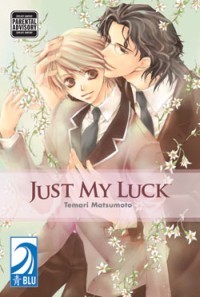
(by Temari Matsumoto, BLU, $9.99)
FROM THE BACK COVER:
"Asahi is constantly running into trouble because of his bad luck ... until a 'purifying' kiss from Rokujou-sensei, his school's divination advisor, allows him to pass an entire day free of misfortune! But is it only Asahi's bad luck that is about to change? From the creator of Shinobu Kokoro and the artist of Kyo Kara Maoh! comes a steamy tale that proves that love—and luck—are all you need for true happiness.
Includes two bonus stories about a toy-maker who falls in love with an android and a school nurse who finds the object for his school uniform fetish!"
EVIDENCE FOR:
The title story in this volume may only take up 100 pages, but in that space it manages to develop a full-fledged plotline. More than just focusing on Asahi and Rokujou's steamy behind-closed-doors relationship, it also has its moments of comedy—the ill-fated recruitment for the Divination Club—and reaches a dramatic finale that reaches into Asahi's past. But deep down, it's still the push-and-pull of forbidden love that drives the story, and the same can be said of the other shorts as well. If there's one theme Matsumoto loves to explore here, it's the emotional journey from a young man's nervous embarrassment to realizing that he does have feelings for someone. Through it all, a humorous undercurrent remains, whether it's the goofy 8-page quickie at the end ("I do like girls, you know") or the tale of the school-uniform fetishist, which is often played for laughs. A stylish sense of line and smooth layouts also make this pleasing to the eye, and the fact that the character designs could pass for Kyo Kara Maoh taken to the next level (hello, Conrad and Wolfram!) doesn't hurt, either.
EVIDENCE AGAINST:
There's something seriously wrong with a BL story when the sex scenes feel tacked-on. Here are these guys, just having a nice little man-to-man relationship, romantic tension on the rise, and then BOOM! Suddenly the clothes are coming off right in the middle of the empty classroom or wherever. Admittedly, this is the whole point of the genre—but when it comes out of nowhere, it just feels awkward, like someone was running out of pages and suddenly had to fulfil the naughty quota. Not to mention that those scenes of consummation have a dry, repetitive feel—it's supposed to be the most loving moment between a couple, but when they're doing the same poses over and over, the sensuality is lost. Even the scenarios repeat themselves, with the school nurse story seemingly a rehash of the main story except with a different member of the faculty. What's with the skeevy student-teacher theme, anyway? Just because the rules of BL are highly specific doesn't mean you have to do the same story over and over.
FINAL VERDICT:
This material is decent enough to fix a craving, but it's nothing creative or special—just the average C.
MUHYO AND ROJI'S BUREAU OF SUPERNATURAL INVESTIGATION
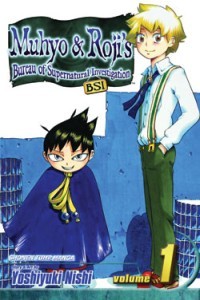
Vol. 1
(by Yoshiyuki Nishi, Viz Media, $7.99)
FROM THE BACK COVER:
"Are you a victim of unwanted spirit possession? Is there a ghost you need sent up and away...or down to burn for all eternity? If the answer is yes, then you need Muhyo and Roji, experts in magic law. Serving justice to evil spirits is their specialty.
When the ghost of a tormented schoolgirl starts terrorizing subway passengers, can Muhyo and Roji resolve the paranormal crisis before it totally derails?"
EVIDENCE FOR:
Just when you thought you knew what kind of creatures lurked on the other side, the bizarre beasts in Muhyo and Roji prove that the monsters within Yoshiyuki Nishi's imagination are a world unto themselves. The vengeful girl at the station is freakish enough, with multiple arms and a looming presence—but now imagine this carrying on from chapter to chapter with limitless possibilities, like a haunted grand piano or a cursed cell phone charm. The only thing more creative than these monsters would be Muhyo's methods of attack, which he pulls out of his magical book of law with reckless abandon. Shooting stuff out of his hands would be far too conventional: instead, spiritual disposal consists of sucking them up into the ground, or having a magic box eat them, or even carting them off on a train to Hell. This supernatural agency may be just one of thousands in the world of manga, but few others can boast such creative methods.
EVIDENCE AGAINST:
Creative monsters and magic are about the only thing this volume gets right, as the rest of it is just the usual, predictable spirit-hunting found in every other series. Lacking any sort of spooky atmosphere or urban-legend vibe, Muhyo and Roji's exploits feel more like artificial "Let's go on an adventure!" romps, with every problem magically resolved within 30 pages. Does it get better later on? Well, there are hints of a deeper world to discover, and the preview for the next volume looks promising, but the actual content in this book is painfully dull. Ugly, juvenile artwork doesn't help either: Nishi may be an ace at drawing fearsome creatures, but his command of the basics seems to be average or worse. The stiff poses, the elementary backgrounds, the unappealing character designs—it's not like this is a talented artist hiding behind a deceptively simple style; it's a simple artist who only knows how to draw in a simple style. At the very least, there should be a strong story or strong artwork—but the way this one is shaping up, it doesn't look like it has either.
FINAL VERDICT:
There are already so many better series about supernatural investigation that this doesn't even belong in a to-read pile. Shuffle it back to the underworld with a C-.
PRINCESS RESURRECTION
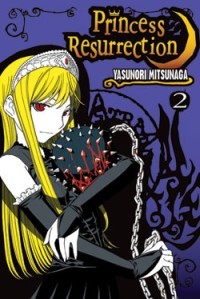
Vol. 2
(by Yasunori Mitsunaga, Del Rey, $10.95)
FROM THE BACK COVER:
"Hiro is a Blood Warrior, which means he's the natural prey of vampires, demons, monsters, and other creatures of the night. Even worse, he needs the help of Hime, the somewhat crazy Princess who gave him the dubious gift of immortal life at the price of eternal servitude. One thing remains clear ... this is Princess Hime's world, and all Hiro can do is try to survive it!"
EVIDENCE FOR:
The second go-round of Princess Resurrection is another delightful horror-action bloodbath. As always, readers can look forward to the genre's most well-known monsters: vampires, werewolves, and giant flesh-eating creepy-crawlies that don't even have names. The only thing more exciting than that, of course, is seeing how Hime and friends dispose of each creature—usually with gruesome results. The arrival of Hime's little sister and her personal combat maid adds a new layer to the ongoing storyline, as does the vampire schoolgirl who is apparently operating under the hand of a higher power. The last two chapters offer a slight twist on the blood-'n'-guts formula of the series; the tale of the android assassin has a surprisingly touching ending, and a dark stormy night at a small motel leads to one of those classic closed-room mystery scenarios. Hime and Hiro's monster-slaying feats will always take center stage, but the series does mix things up from time to time.
EVIDENCE AGAINST:
How can anyone enjoy a horror-action series that's not particularly horrific and sleepwalks its way through the action? The monsters here are unforgivably bland, often relying on name recognition rather than actually being scary (it's a VAMPIRE! Be afraid), and the methods of disposal lack any cleverness or flair. In fact, there are times when the fights don't even make sense; fending off werewolves apparently involves random punches and attacks until you don't know where the scene is taking place and who the combatants are. Hime doesn't even pull out her chainsaw this entire volume, which may very well be the biggest disappointment for some. It's also hard to get attached to any of the characters in the series when monster-battling becomes more important than their personalities. Also devoid of personality is the artwork, which is about as dull and amateurish as you can get. (Always be wary of comics where the artist can't even get hands right.) When the scary evil monsters look more like children's cartoon characters, and one of the pivotal scenes makes use of a photocopied background, there's clearly not much talent at work.
FINAL VERDICT:
Horror themes and bloody battles are always popular, but when one comes out that's this lame, it's going to get stuck with a D.
TOGARI
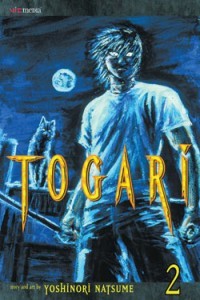
Vol. 2
(by Yoshinori Natsume, Viz Media, $9.99)
FROM THE BACK COVER:
"Tobei, a ruthless punk from feudal Japan, has been damned to hell for the past 300 years. Given a chance for redemption, he's sent to the present to vanquish sins that have taken the form of malevolent spirits called Toga. Armed with the sin-slaying sword Togari, Tobei is about to go medieval on the 21st century!
Tobei encounters something he's never experienced before—the kindness of friends. But before he even has a chance to think, new and more powerful Toga appear before him. Time is ticking away, and there are plenty more sins to be conquered!"
EVIDENCE FOR:
Togari may look like your usual supernatural action-slasher, but there's one little trick up its sleeve: it's also a time-traveling fish-out-of-water comedy. Tobei's maniacal sword-swinging attitude is the main attraction, but the real entertainment comes from his utter bewilderment at modern-day Japan. This volume is a goldmine of culture-clash moments: Tobei's fear of the television ("How did they get all those little samurai in there?!"), his newfound fascination with trains, and the awkwardness of wearing a suit and tie. But if this all seems too silly, don't worry—the action scenes are still as hardcore as ever, with Tobei smashing his way through each accursed Toga. Even when you know it's coming, there's still something spine-chilling about the way he puts on the angry eyes and snarls "Your sin ... is mine!" Then comes the payoff, as he launches into speedline-laced battles against common criminals and delivers his brand of terrifying, vigilante justice. How is it that someone so evil ends up working for the side of good? Contrasting moralities combined with a story of contrasting genres—now that's a potent mix.
EVIDENCE AGAINST:
With Tobei's quest still in its early stages—he's got to vanquish 108 sins and only has 4 so far at the start of this volume—the story feels pretty repetitive right now. The only real difference from chapter to chapter is what kind of sinner he's after (a mugger on the street; a salaryman bent on insurance fraud) and how many pages it takes for him to dispose of the miscreant. Even the action scenes, thrilling as they are, all start to look the same: he spots the Toga, goes into berserker mode, and does something crazy with the sword that takes up a two-page spread. Always the two-page spread. Regular page layouts also suffer from a lack of variety, relying almost entirely on a three-row pattern of panels. How is it that a story with such dynamic ideas can allow itself to be constrained to such a boring format? Look, even the time-travel gags are old hat, having been used in plenty of other guy-from-the-past-visits-the-future tales already. It's like Togari is taking everything old and trying to make it new again ... and failing.
FINAL VERDICT:
The worst you can really say about Togari is that it often dips into averageness—but there are still enough times when the action and characters raise it to a B.
WELCOME TO THE NHK (novel)
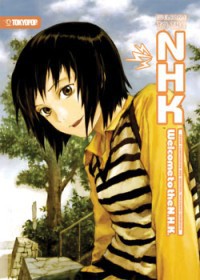
(by Tatsuhiko Takimoto, Tokyopop, $7.99)
FROM THE BACK COVER:
"Twenty-two-year-old Satou, a college dropout and aficionado of anime porn, knows a little secret—or at least he thinks he does! Believe it or not, he has stumbled upon an incredible conspiracy created by the Japanese Broadcasting Company, NHK. But despite fighting the good fight, Satou has become an unemployed hikikomori—a shut-in who has withdrawn from the world...
One day, he meets Misaki, a mysterious young girl who invites him to join her special 'project.' Slowly, Satou comes out of his reclusive shell, and his hilarious journey begins, filled with mistaken identity, Lolita complexes—and an ultimate quest to create the greatest hentai game ever!"
EVIDENCE FOR:
Here it is at last: the true, original Welcome to the NHK, based on Tatsuhiko Takimoto's own real-life experiences as a hikikomori. If you think you know the story from its illustrated adaptations, think again. Say goodbye to hur-hur-otaku-lifestyle humor—Satou doesn't even go anime shopping or online gaming in the novel—and say hello to a deeply harrowing account of mental imbalance. It's only in this version that we truly get inside the main character's head, and it turns out to be quite a disturbing place: streams of self-loathing monologue, suicidal tendencies, paranoia, and heavy drug use. That's right, Satou (along with otaku neighbor Yamazaki) goes on plenty of hallucinogenic trips, describing each one in surreal detail. This, among other things, is the perfect portrait of a life spiraling out of control: a stint of pedophilia that is neither humorous nor offensive, but simply pitiful; an encounter with a cult that exposes the folly of believers and nonbelievers alike; and in the final act, a battle of minds where the two most dysfunctional people in the world must save each other. The plot may not be as wild and wacky as the manga or anime, but it is much more intense—a psychological drama in every sense of the word.
EVIDENCE AGAINST:
See, this is what happens when you let mentally imbalanced people prattle on for 200 pages and then publish it. Reading the novel is far from an entertaining experience, unless circular ramblings of depression are your idea of entertainment. Often times it feels like Satou's narration is just there to take up space, and his misadventures as a hikikomori jump from event to event without much logic or reason. (Then again, his state of mind is the very furthest thing from logical...) The plot only comes together towards the end, and even then it's only the thinnest of threads connecting the early chapters to the grand finale. Oh, and let's hope that someday this gets re-translated into an edition that's less fixated on literal authenticity. There's a lot of clunky wording to be found here, with some idiomatic Japanese phrases converting into English lines that no one would say, as well as a couple of failed puns. The glossary in the back also falls short, with its questionable range of words—sure, it explains what a "kotatsu" is, yet it skips a slang buzzword like "lolicon"? Where the hell are people supposed to look that up, on an anime website?
FINAL VERDICT:
Despite the sometimes awkward writing, this mind-warping character drama and critique of society still earns itself an A-.

GOTHIC SPORTS
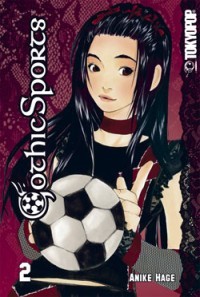
Vol. 2
(by Anike Hage, Tokyopop, $9.99)
FROM THE BACK COVER:
"It's been a hard road, but Anya is determined to start her own soccer team. And thanks to her friend Filiz's inspirational Gothic Lolita jersey design, the topsy-turvy team has started to attract some serious attention. Do they have what it takes to compete with the official school team? It's going to take more than indie cred and high fashion if they want to take their game to the next level!"
EVIDENCE FOR:
If the true essence of sports is drama and emotion, then Anike Hage knows exactly how to put it on the page. The tension of Anya's do-or-die soccer match is plain to see on her face, as well as that of her teammates; the best scenes in this volume are definitely the close-ups. With sure-handed technique, an attractive cast of characters, and breezy, effortless layouts, Hage's artwork is proof that Western artists are capable of understanding the style. Feuds and relationships from Volume 1 expand to the next level here, especially with Anya and Leon's inexplicable hatred finally getting some back story. If anything, the interaction between characters is just as compelling as the actual gameplay—Anya's fluctuating emotions, the gruffness of the varsity team (and their coach), and the decisive actions taken by star athlete Delia. The climax of the match is a genuine thrill, and even ordinary school-day events keep the excitement level up because there's as much investment in the characters as there is in the actual sport. These kids might play soccer in funny uniforms, but they're still normal teenagers that we can all understand.
EVIDENCE AGAINST:
You can throw in all the teenage drama you want, but if a sports title isn't getting the sports part right, then something is seriously wrong. The soccer match takes up two-thirds of a volume but never really gets into the pace of the game, instead stopping at all the most awkward moments for conversations and arguments and self-reflection. Where's the action, people? Things do pick up once Delia arrives, but even her highlight scenes lack visual excitement—this would be a case of having not enough speedlines, and failing to use dynamic angles. Ah, so much craftsmanship put into the character designs, but not enough put into the character motions. Even their behavior and motivation doesn't make sense at times—what are we supposed to make of Anya breaking out in laughter, or the lackadaisical attitude of the referee? Is there some point to this? This story could be covering a lot more ground in the space it's given, but instead, people are waffling around with emotional outbursts that add nothing to the context of the story. Maybe that's why it's taken two whole volumes for the team just to get together and play one game: they're too busy farting around and showing off their attitude.
FINAL VERDICT:
It is, at times, still a fun read with clean, expressive artwork, but the story had better pick up soon or it's going to clink right off the goalposts and into failure.
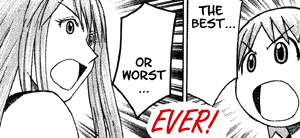
Just because it's mainstream, doesn't mean it's trash! If something is popular, it might just be because it's one of the Best Manga I've Ever Read:
FULLMETAL ALCHEMIST
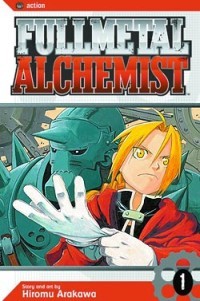
(by Hiromu Arakawa, Viz Media, $9.99 ea.)
Trying to stand out in the action-adventure genre is like being a white cow in a snowstorm. But somehow, Fullmetal Alchemist rises above its peers, with an epic story that is gripping, entertaining, heartbreaking, thought-provoking, and much more. Most folks know the story by now: Edward Elric, a young genius at alchemy, tried to bring back his deceased mother and set off a terrible accident, losing an arm and a leg and transferring the soul of his brother Alphonse into a suit of armor. Now equipped with mechanical limbs and working as a State Alchemist, Ed and his brother begin their quest for the Philosopher's Stone, hoping to bring things back to normal. However, they gradually uncover a conspiracy where dark forces are creating Homunculi, artificial creatures, which could undermine the very foundations of alchemy and life itself.
Hmm ... put that way, it sounds very over-simplified. There's a whole lot more to it than quick summaries could never explain. Fullmetal Alchemist is a sprawling story yet tightly plotted—everything connects to everything else, even when you've got, say, five plotlines involving thirty-odd characters (which would not be an exaggeration). Roy Mustang and his military forces aren't just supporting characters, but essential players in Ed's quest and the conspiracy at large. Friends and allies like mentor Izumi and mechanic Winry aren't just there to provide power-ups, but help the Elric brothers to grow in their hearts and minds. Even the villains, so appropriately named after the Seven Deadly Sins, have personal motivations that go beyond just bloodlust. Simply put, this is the series that has it all: tales of familial love, coming of age, personal sacrifice, heart-stopping action, science and magic, and of course, a healthy dose of humor. (Who doesn't love Major Armstrong?) Clean, dynamic artwork provides the finishing touch, with a parade of unique character designs and memorable locales. It's an ambitious work spanning many moods, genres and styles—all within a single, powerful story—and Hiromu Arakawa has met the challenge magnificently.
discuss this in the forum (34 posts) |